SITXWHS002 - WHS Risk Assessment of Orica Explosives Manufacturing
VerifiedAdded on 2023/06/07
|8
|1865
|164
Project
AI Summary
This document presents a WHS risk assessment conducted for Orica's explosives manufacturing department, focusing on hazard identification, risk assessment, and control measures. The assessment covers various workplace activities, including handling poisonous ingredients, packing explosives, heavy material operation, drilling, and handling heated machinery. Identified hazards range from chemical leakages and physical injuries to noise, vibration, radiation, and thermal stress. The assessment outlines existing control measures such as PPE usage, fire safety protocols, and radiation protection, along with recommended actions like training, equipment upgrades, and shift management. A risk analysis matrix is included to categorize risks based on likelihood and consequence, with corresponding control hierarchies. The document also includes a bibliography, citing relevant sources on occupational health and safety.
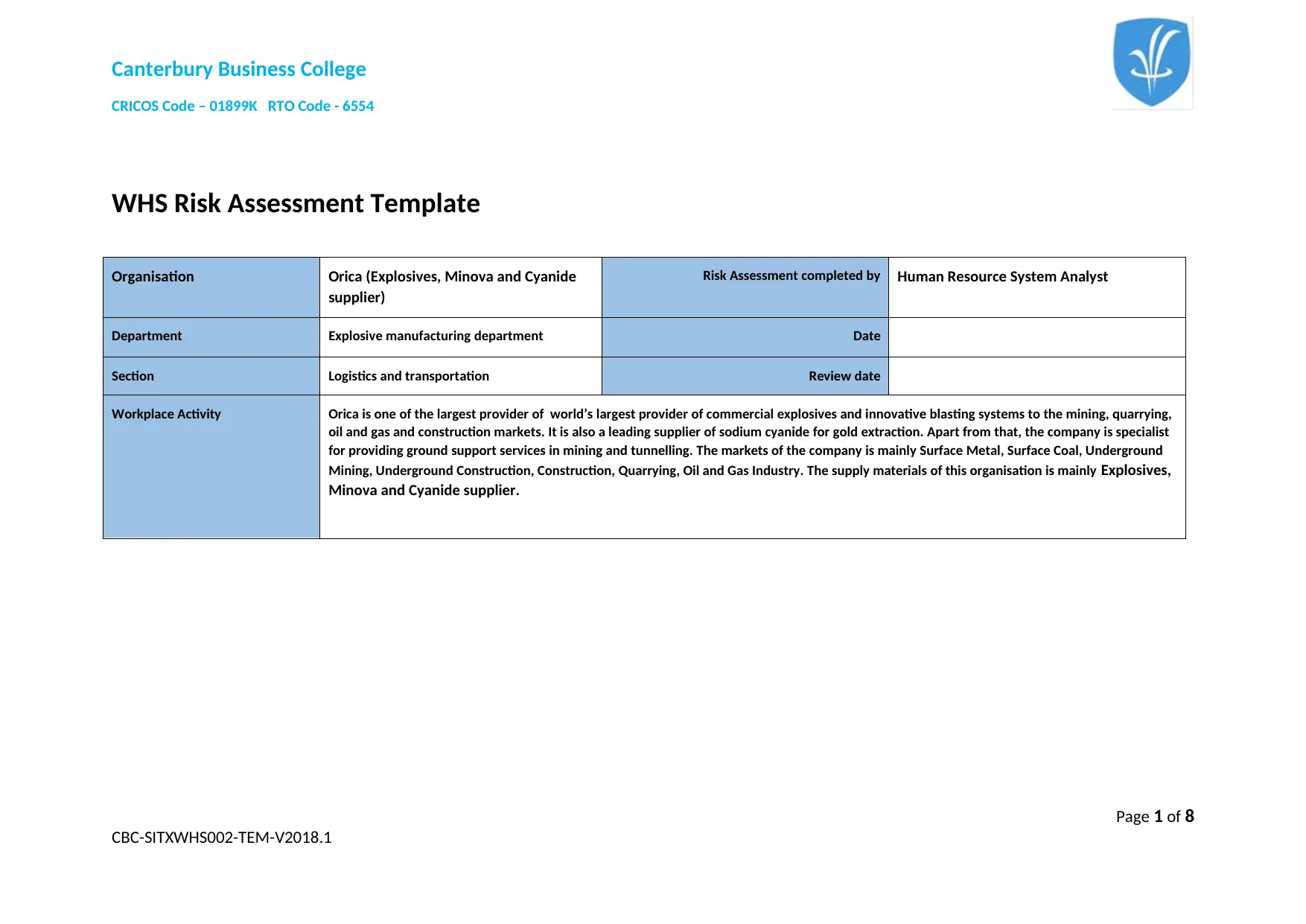
Canterbury Business College
CRICOS Code – 01899K RTO Code - 6554
WHS Risk Assessment Template
Organisation Orica (Explosives, Minova and Cyanide
supplier)
Risk Assessment completed by Human Resource System Analyst
Department Explosive manufacturing department Date
Section Logistics and transportation Review date
Workplace Activity Orica is one of the largest provider of world’s largest provider of commercial explosives and innovative blasting systems to the mining, quarrying,
oil and gas and construction markets. It is also a leading supplier of sodium cyanide for gold extraction. Apart from that, the company is specialist
for providing ground support services in mining and tunnelling. The markets of the company is mainly Surface Metal, Surface Coal, Underground
Mining, Underground Construction, Construction, Quarrying, Oil and Gas Industry. The supply materials of this organisation is mainly Explosives,
Minova and Cyanide supplier.
Page 1 of 8
CBC-SITXWHS002-TEM-V2018.1
CRICOS Code – 01899K RTO Code - 6554
WHS Risk Assessment Template
Organisation Orica (Explosives, Minova and Cyanide
supplier)
Risk Assessment completed by Human Resource System Analyst
Department Explosive manufacturing department Date
Section Logistics and transportation Review date
Workplace Activity Orica is one of the largest provider of world’s largest provider of commercial explosives and innovative blasting systems to the mining, quarrying,
oil and gas and construction markets. It is also a leading supplier of sodium cyanide for gold extraction. Apart from that, the company is specialist
for providing ground support services in mining and tunnelling. The markets of the company is mainly Surface Metal, Surface Coal, Underground
Mining, Underground Construction, Construction, Quarrying, Oil and Gas Industry. The supply materials of this organisation is mainly Explosives,
Minova and Cyanide supplier.
Page 1 of 8
CBC-SITXWHS002-TEM-V2018.1
Paraphrase This Document
Need a fresh take? Get an instant paraphrase of this document with our AI Paraphraser
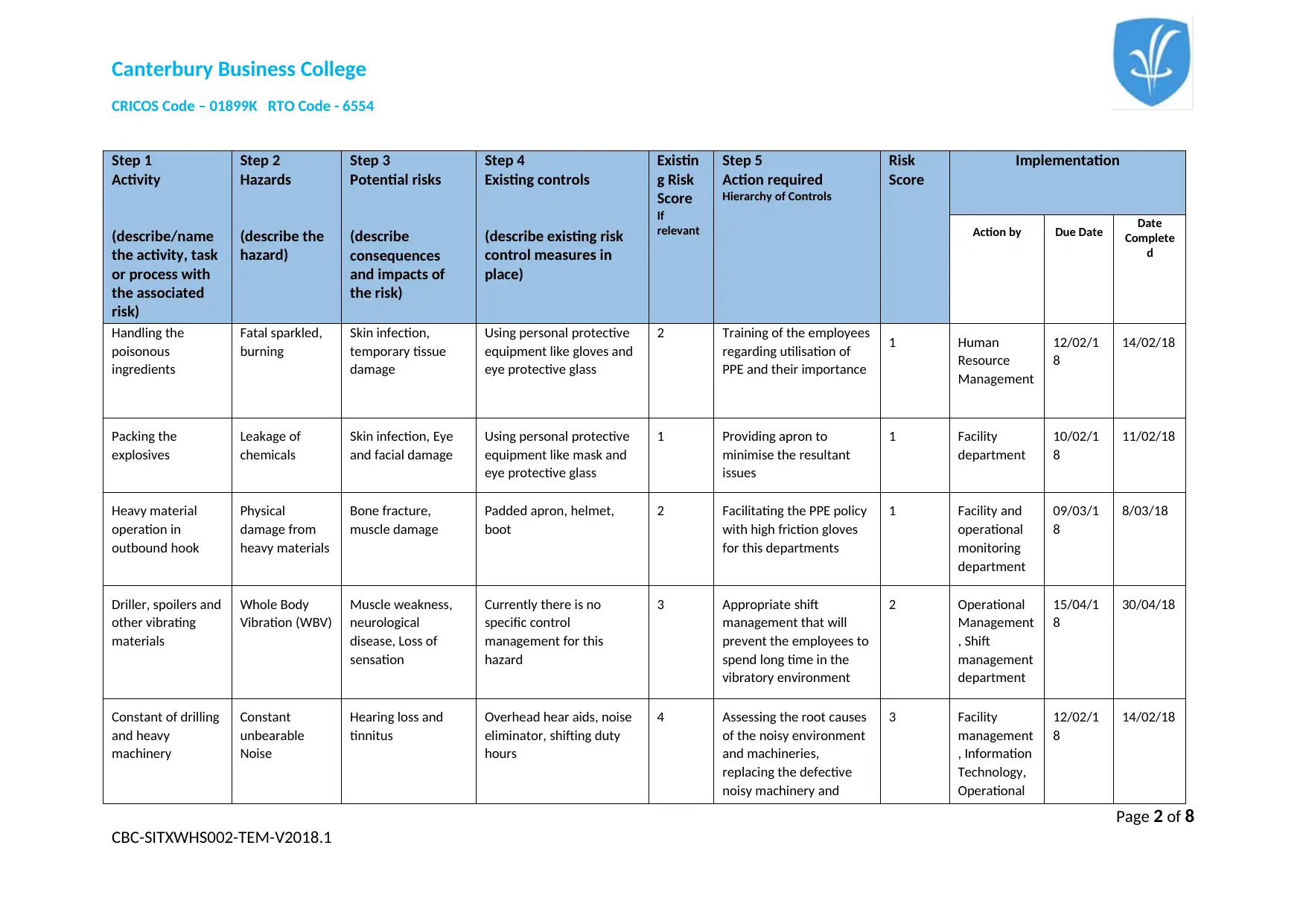
Canterbury Business College
CRICOS Code – 01899K RTO Code - 6554
Step 1
Activity
(describe/name
the activity, task
or process with
the associated
risk)
Step 2
Hazards
(describe the
hazard)
Step 3
Potential risks
(describe
consequences
and impacts of
the risk)
Step 4
Existing controls
(describe existing risk
control measures in
place)
Existin
g Risk
Score
If
relevant
Step 5
Action required
Hierarchy of Controls
Risk
Score
Implementation
Action by Due Date Date
Complete
d
Handling the
poisonous
ingredients
Fatal sparkled,
burning
Skin infection,
temporary tissue
damage
Using personal protective
equipment like gloves and
eye protective glass
2 Training of the employees
regarding utilisation of
PPE and their importance
1 Human
Resource
Management
12/02/1
8
14/02/18
Packing the
explosives
Leakage of
chemicals
Skin infection, Eye
and facial damage
Using personal protective
equipment like mask and
eye protective glass
1 Providing apron to
minimise the resultant
issues
1 Facility
department
10/02/1
8
11/02/18
Heavy material
operation in
outbound hook
Physical
damage from
heavy materials
Bone fracture,
muscle damage
Padded apron, helmet,
boot
2 Facilitating the PPE policy
with high friction gloves
for this departments
1 Facility and
operational
monitoring
department
09/03/1
8
8/03/18
Driller, spoilers and
other vibrating
materials
Whole Body
Vibration (WBV)
Muscle weakness,
neurological
disease, Loss of
sensation
Currently there is no
specific control
management for this
hazard
3 Appropriate shift
management that will
prevent the employees to
spend long time in the
vibratory environment
2 Operational
Management
, Shift
management
department
15/04/1
8
30/04/18
Constant of drilling
and heavy
machinery
Constant
unbearable
Noise
Hearing loss and
tinnitus
Overhead hear aids, noise
eliminator, shifting duty
hours
4 Assessing the root causes
of the noisy environment
and machineries,
replacing the defective
noisy machinery and
3 Facility
management
, Information
Technology,
Operational
12/02/1
8
14/02/18
Page 2 of 8
CBC-SITXWHS002-TEM-V2018.1
CRICOS Code – 01899K RTO Code - 6554
Step 1
Activity
(describe/name
the activity, task
or process with
the associated
risk)
Step 2
Hazards
(describe the
hazard)
Step 3
Potential risks
(describe
consequences
and impacts of
the risk)
Step 4
Existing controls
(describe existing risk
control measures in
place)
Existin
g Risk
Score
If
relevant
Step 5
Action required
Hierarchy of Controls
Risk
Score
Implementation
Action by Due Date Date
Complete
d
Handling the
poisonous
ingredients
Fatal sparkled,
burning
Skin infection,
temporary tissue
damage
Using personal protective
equipment like gloves and
eye protective glass
2 Training of the employees
regarding utilisation of
PPE and their importance
1 Human
Resource
Management
12/02/1
8
14/02/18
Packing the
explosives
Leakage of
chemicals
Skin infection, Eye
and facial damage
Using personal protective
equipment like mask and
eye protective glass
1 Providing apron to
minimise the resultant
issues
1 Facility
department
10/02/1
8
11/02/18
Heavy material
operation in
outbound hook
Physical
damage from
heavy materials
Bone fracture,
muscle damage
Padded apron, helmet,
boot
2 Facilitating the PPE policy
with high friction gloves
for this departments
1 Facility and
operational
monitoring
department
09/03/1
8
8/03/18
Driller, spoilers and
other vibrating
materials
Whole Body
Vibration (WBV)
Muscle weakness,
neurological
disease, Loss of
sensation
Currently there is no
specific control
management for this
hazard
3 Appropriate shift
management that will
prevent the employees to
spend long time in the
vibratory environment
2 Operational
Management
, Shift
management
department
15/04/1
8
30/04/18
Constant of drilling
and heavy
machinery
Constant
unbearable
Noise
Hearing loss and
tinnitus
Overhead hear aids, noise
eliminator, shifting duty
hours
4 Assessing the root causes
of the noisy environment
and machineries,
replacing the defective
noisy machinery and
3 Facility
management
, Information
Technology,
Operational
12/02/1
8
14/02/18
Page 2 of 8
CBC-SITXWHS002-TEM-V2018.1
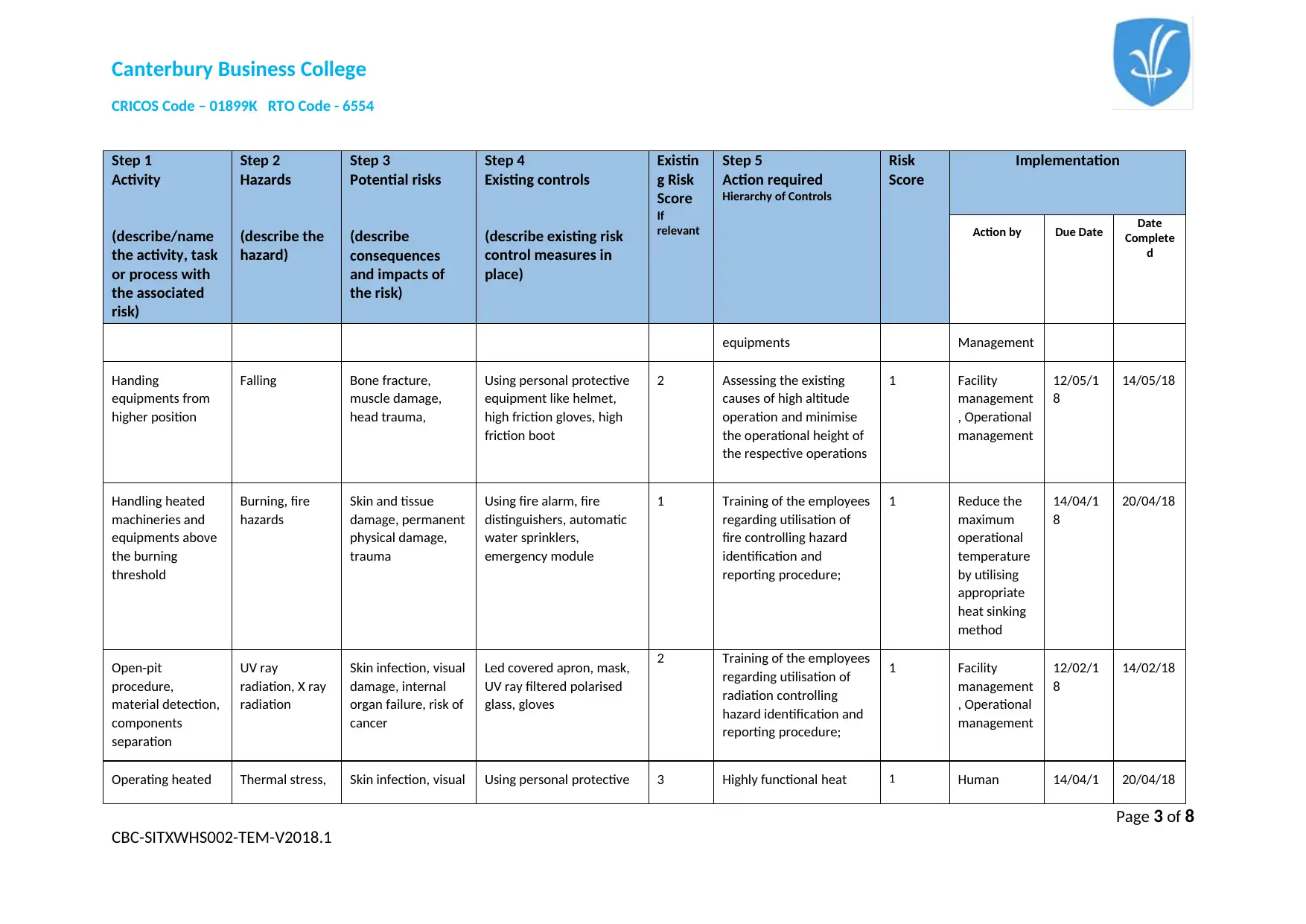
Canterbury Business College
CRICOS Code – 01899K RTO Code - 6554
Step 1
Activity
(describe/name
the activity, task
or process with
the associated
risk)
Step 2
Hazards
(describe the
hazard)
Step 3
Potential risks
(describe
consequences
and impacts of
the risk)
Step 4
Existing controls
(describe existing risk
control measures in
place)
Existin
g Risk
Score
If
relevant
Step 5
Action required
Hierarchy of Controls
Risk
Score
Implementation
Action by Due Date Date
Complete
d
equipments Management
Handing
equipments from
higher position
Falling Bone fracture,
muscle damage,
head trauma,
Using personal protective
equipment like helmet,
high friction gloves, high
friction boot
2 Assessing the existing
causes of high altitude
operation and minimise
the operational height of
the respective operations
1 Facility
management
, Operational
management
12/05/1
8
14/05/18
Handling heated
machineries and
equipments above
the burning
threshold
Burning, fire
hazards
Skin and tissue
damage, permanent
physical damage,
trauma
Using fire alarm, fire
distinguishers, automatic
water sprinklers,
emergency module
1 Training of the employees
regarding utilisation of
fire controlling hazard
identification and
reporting procedure;
1 Reduce the
maximum
operational
temperature
by utilising
appropriate
heat sinking
method
14/04/1
8
20/04/18
Open-pit
procedure,
material detection,
components
separation
UV ray
radiation, X ray
radiation
Skin infection, visual
damage, internal
organ failure, risk of
cancer
Led covered apron, mask,
UV ray filtered polarised
glass, gloves
2 Training of the employees
regarding utilisation of
radiation controlling
hazard identification and
reporting procedure;
1 Facility
management
, Operational
management
12/02/1
8
14/02/18
Operating heated Thermal stress, Skin infection, visual Using personal protective 3 Highly functional heat 1 Human 14/04/1 20/04/18
Page 3 of 8
CBC-SITXWHS002-TEM-V2018.1
CRICOS Code – 01899K RTO Code - 6554
Step 1
Activity
(describe/name
the activity, task
or process with
the associated
risk)
Step 2
Hazards
(describe the
hazard)
Step 3
Potential risks
(describe
consequences
and impacts of
the risk)
Step 4
Existing controls
(describe existing risk
control measures in
place)
Existin
g Risk
Score
If
relevant
Step 5
Action required
Hierarchy of Controls
Risk
Score
Implementation
Action by Due Date Date
Complete
d
equipments Management
Handing
equipments from
higher position
Falling Bone fracture,
muscle damage,
head trauma,
Using personal protective
equipment like helmet,
high friction gloves, high
friction boot
2 Assessing the existing
causes of high altitude
operation and minimise
the operational height of
the respective operations
1 Facility
management
, Operational
management
12/05/1
8
14/05/18
Handling heated
machineries and
equipments above
the burning
threshold
Burning, fire
hazards
Skin and tissue
damage, permanent
physical damage,
trauma
Using fire alarm, fire
distinguishers, automatic
water sprinklers,
emergency module
1 Training of the employees
regarding utilisation of
fire controlling hazard
identification and
reporting procedure;
1 Reduce the
maximum
operational
temperature
by utilising
appropriate
heat sinking
method
14/04/1
8
20/04/18
Open-pit
procedure,
material detection,
components
separation
UV ray
radiation, X ray
radiation
Skin infection, visual
damage, internal
organ failure, risk of
cancer
Led covered apron, mask,
UV ray filtered polarised
glass, gloves
2 Training of the employees
regarding utilisation of
radiation controlling
hazard identification and
reporting procedure;
1 Facility
management
, Operational
management
12/02/1
8
14/02/18
Operating heated Thermal stress, Skin infection, visual Using personal protective 3 Highly functional heat 1 Human 14/04/1 20/04/18
Page 3 of 8
CBC-SITXWHS002-TEM-V2018.1
⊘ This is a preview!⊘
Do you want full access?
Subscribe today to unlock all pages.

Trusted by 1+ million students worldwide
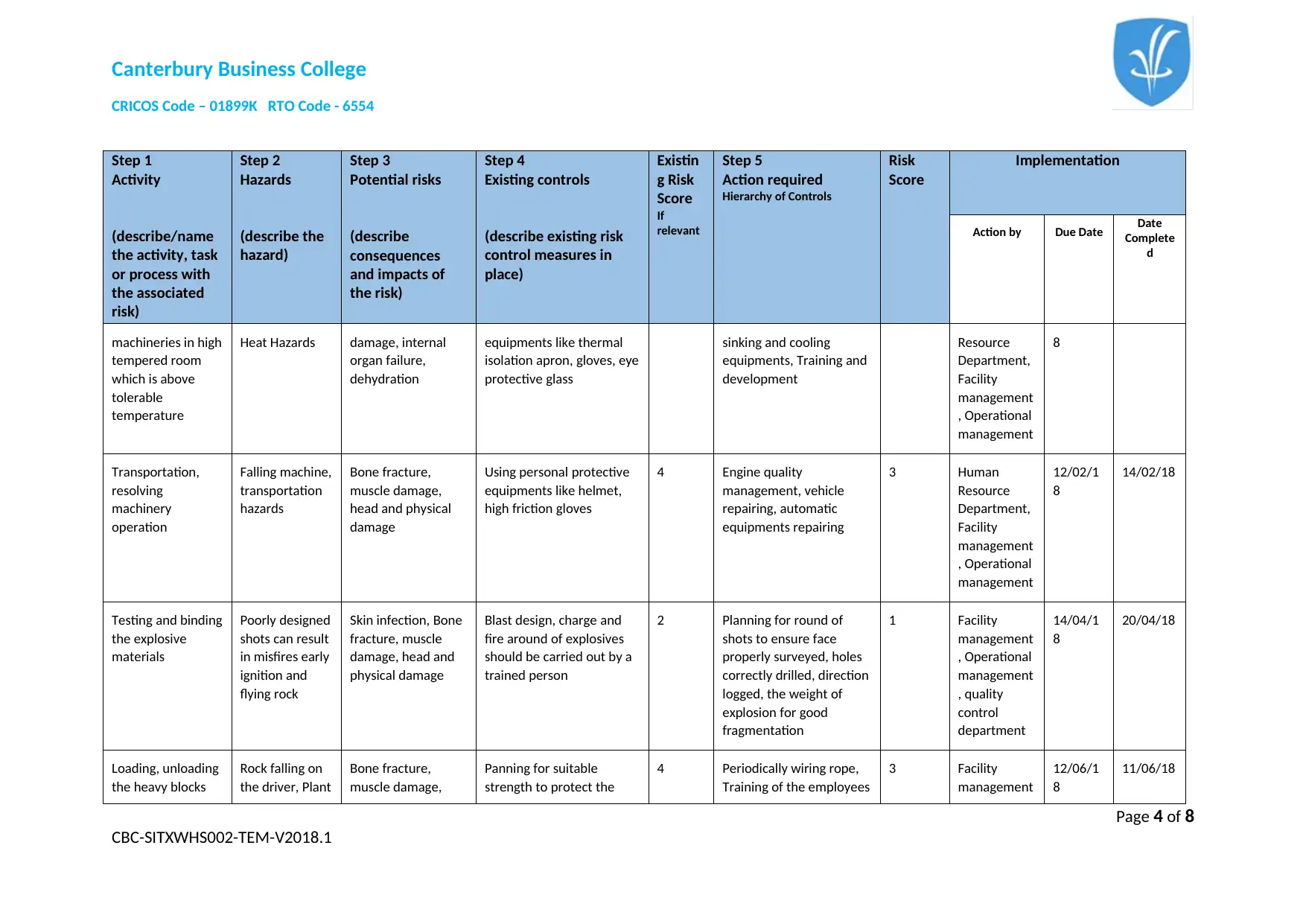
Canterbury Business College
CRICOS Code – 01899K RTO Code - 6554
Step 1
Activity
(describe/name
the activity, task
or process with
the associated
risk)
Step 2
Hazards
(describe the
hazard)
Step 3
Potential risks
(describe
consequences
and impacts of
the risk)
Step 4
Existing controls
(describe existing risk
control measures in
place)
Existin
g Risk
Score
If
relevant
Step 5
Action required
Hierarchy of Controls
Risk
Score
Implementation
Action by Due Date Date
Complete
d
machineries in high
tempered room
which is above
tolerable
temperature
Heat Hazards damage, internal
organ failure,
dehydration
equipments like thermal
isolation apron, gloves, eye
protective glass
sinking and cooling
equipments, Training and
development
Resource
Department,
Facility
management
, Operational
management
8
Transportation,
resolving
machinery
operation
Falling machine,
transportation
hazards
Bone fracture,
muscle damage,
head and physical
damage
Using personal protective
equipments like helmet,
high friction gloves
4 Engine quality
management, vehicle
repairing, automatic
equipments repairing
3 Human
Resource
Department,
Facility
management
, Operational
management
12/02/1
8
14/02/18
Testing and binding
the explosive
materials
Poorly designed
shots can result
in misfires early
ignition and
flying rock
Skin infection, Bone
fracture, muscle
damage, head and
physical damage
Blast design, charge and
fire around of explosives
should be carried out by a
trained person
2 Planning for round of
shots to ensure face
properly surveyed, holes
correctly drilled, direction
logged, the weight of
explosion for good
fragmentation
1 Facility
management
, Operational
management
, quality
control
department
14/04/1
8
20/04/18
Loading, unloading
the heavy blocks
Rock falling on
the driver, Plant
Bone fracture,
muscle damage,
Panning for suitable
strength to protect the
4 Periodically wiring rope,
Training of the employees
3 Facility
management
12/06/1
8
11/06/18
Page 4 of 8
CBC-SITXWHS002-TEM-V2018.1
CRICOS Code – 01899K RTO Code - 6554
Step 1
Activity
(describe/name
the activity, task
or process with
the associated
risk)
Step 2
Hazards
(describe the
hazard)
Step 3
Potential risks
(describe
consequences
and impacts of
the risk)
Step 4
Existing controls
(describe existing risk
control measures in
place)
Existin
g Risk
Score
If
relevant
Step 5
Action required
Hierarchy of Controls
Risk
Score
Implementation
Action by Due Date Date
Complete
d
machineries in high
tempered room
which is above
tolerable
temperature
Heat Hazards damage, internal
organ failure,
dehydration
equipments like thermal
isolation apron, gloves, eye
protective glass
sinking and cooling
equipments, Training and
development
Resource
Department,
Facility
management
, Operational
management
8
Transportation,
resolving
machinery
operation
Falling machine,
transportation
hazards
Bone fracture,
muscle damage,
head and physical
damage
Using personal protective
equipments like helmet,
high friction gloves
4 Engine quality
management, vehicle
repairing, automatic
equipments repairing
3 Human
Resource
Department,
Facility
management
, Operational
management
12/02/1
8
14/02/18
Testing and binding
the explosive
materials
Poorly designed
shots can result
in misfires early
ignition and
flying rock
Skin infection, Bone
fracture, muscle
damage, head and
physical damage
Blast design, charge and
fire around of explosives
should be carried out by a
trained person
2 Planning for round of
shots to ensure face
properly surveyed, holes
correctly drilled, direction
logged, the weight of
explosion for good
fragmentation
1 Facility
management
, Operational
management
, quality
control
department
14/04/1
8
20/04/18
Loading, unloading
the heavy blocks
Rock falling on
the driver, Plant
Bone fracture,
muscle damage,
Panning for suitable
strength to protect the
4 Periodically wiring rope,
Training of the employees
3 Facility
management
12/06/1
8
11/06/18
Page 4 of 8
CBC-SITXWHS002-TEM-V2018.1
Paraphrase This Document
Need a fresh take? Get an instant paraphrase of this document with our AI Paraphraser

Canterbury Business College
CRICOS Code – 01899K RTO Code - 6554
Step 1
Activity
(describe/name
the activity, task
or process with
the associated
risk)
Step 2
Hazards
(describe the
hazard)
Step 3
Potential risks
(describe
consequences
and impacts of
the risk)
Step 4
Existing controls
(describe existing risk
control measures in
place)
Existin
g Risk
Score
If
relevant
Step 5
Action required
Hierarchy of Controls
Risk
Score
Implementation
Action by Due Date Date
Complete
d
and packages toppling aver
due to uneven
ground, Failure
of hydraulic
system
head and physical
damage
driver, Electrical supply to
dragline
regarding utilisation
loading and unloading
hook
, Operational
management
, quality
control
department
Grinding and
Screening
Dust , Noise,
Vibration, Fall
from height
during
maintenance
Vision and hearing
loss, physical
damage, internal
tissue damage
Using personal protective
equipments like isolated
apron, gloves, eye
protective glass
3 Engine quality
management, automatic
equipments repairing,
Training and development
2 Human
Resource
Department,
Facility
management
, Operational
management
18/05/1
8
22/05/18
Risk Analysis matrix – Level of risk
Identified Hazards Risk Assessment Risk Score Risk Level Action
Likelihood
(L)
Consequence
(C)
L x C
Page 5 of 8
CBC-SITXWHS002-TEM-V2018.1
CRICOS Code – 01899K RTO Code - 6554
Step 1
Activity
(describe/name
the activity, task
or process with
the associated
risk)
Step 2
Hazards
(describe the
hazard)
Step 3
Potential risks
(describe
consequences
and impacts of
the risk)
Step 4
Existing controls
(describe existing risk
control measures in
place)
Existin
g Risk
Score
If
relevant
Step 5
Action required
Hierarchy of Controls
Risk
Score
Implementation
Action by Due Date Date
Complete
d
and packages toppling aver
due to uneven
ground, Failure
of hydraulic
system
head and physical
damage
driver, Electrical supply to
dragline
regarding utilisation
loading and unloading
hook
, Operational
management
, quality
control
department
Grinding and
Screening
Dust , Noise,
Vibration, Fall
from height
during
maintenance
Vision and hearing
loss, physical
damage, internal
tissue damage
Using personal protective
equipments like isolated
apron, gloves, eye
protective glass
3 Engine quality
management, automatic
equipments repairing,
Training and development
2 Human
Resource
Department,
Facility
management
, Operational
management
18/05/1
8
22/05/18
Risk Analysis matrix – Level of risk
Identified Hazards Risk Assessment Risk Score Risk Level Action
Likelihood
(L)
Consequence
(C)
L x C
Page 5 of 8
CBC-SITXWHS002-TEM-V2018.1

Canterbury Business College
CRICOS Code – 01899K RTO Code - 6554
Leakage of chemicals 2 2 4 Moderate Providing apron and training
development
Noise and Vibration, 1 3 3 Low Engine quality management, automatic
equipments repairing,
Fall from height 3 1 4 Moderate Shift management, training and
development
early ignition and flying rock 2 4 8 High Periodically wiring rope, Training of the
employees regarding utilisation loading
and unloading hook
UV ray radiation, X ray
radiation
2 2 4 Moderate Training of the employees regarding
utilisation of radiation controlling hazard
identification and reporting procedure
Thermal stress 4 3 1
2
Very high Highly functional heat sinking and
cooling equipments, Training and
development
Definitions
Likelihood L Score Consequence C Score Risk Score (L x
C)
Hierarchy of Risk Controls
Rare (Monthly) 1 Minor – e.g. small cut, first
aid treatment only
1 Elimination is a permanent solution and should be attempted in the first
instance.
Occasionally
(Weekly)
2 Moderate – e.g. sprained
ankle, one day off required
2 Substitution involves replacing the hazard or environmental aspect by one of
lower risk.
Page 6 of 8
CBC-SITXWHS002-TEM-V2018.1
CRICOS Code – 01899K RTO Code - 6554
Leakage of chemicals 2 2 4 Moderate Providing apron and training
development
Noise and Vibration, 1 3 3 Low Engine quality management, automatic
equipments repairing,
Fall from height 3 1 4 Moderate Shift management, training and
development
early ignition and flying rock 2 4 8 High Periodically wiring rope, Training of the
employees regarding utilisation loading
and unloading hook
UV ray radiation, X ray
radiation
2 2 4 Moderate Training of the employees regarding
utilisation of radiation controlling hazard
identification and reporting procedure
Thermal stress 4 3 1
2
Very high Highly functional heat sinking and
cooling equipments, Training and
development
Definitions
Likelihood L Score Consequence C Score Risk Score (L x
C)
Hierarchy of Risk Controls
Rare (Monthly) 1 Minor – e.g. small cut, first
aid treatment only
1 Elimination is a permanent solution and should be attempted in the first
instance.
Occasionally
(Weekly)
2 Moderate – e.g. sprained
ankle, one day off required
2 Substitution involves replacing the hazard or environmental aspect by one of
lower risk.
Page 6 of 8
CBC-SITXWHS002-TEM-V2018.1
⊘ This is a preview!⊘
Do you want full access?
Subscribe today to unlock all pages.

Trusted by 1+ million students worldwide
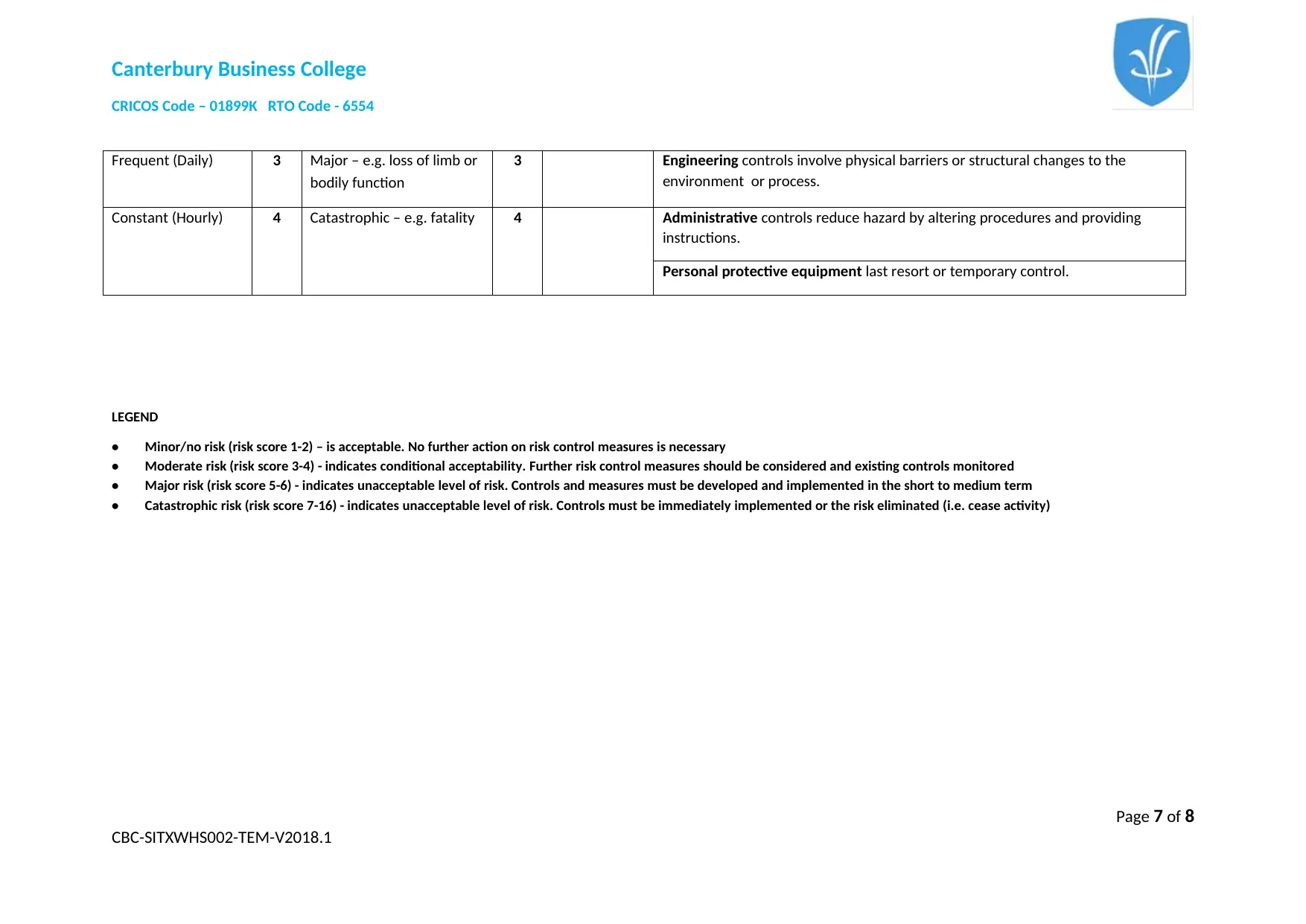
Canterbury Business College
CRICOS Code – 01899K RTO Code - 6554
Frequent (Daily) 3 Major – e.g. loss of limb or
bodily function
3 Engineering controls involve physical barriers or structural changes to the
environment or process.
Constant (Hourly) 4 Catastrophic – e.g. fatality 4 Administrative controls reduce hazard by altering procedures and providing
instructions.
Personal protective equipment last resort or temporary control.
LEGEND
• Minor/no risk (risk score 1-2) – is acceptable. No further action on risk control measures is necessary
• Moderate risk (risk score 3-4) - indicates conditional acceptability. Further risk control measures should be considered and existing controls monitored
• Major risk (risk score 5-6) - indicates unacceptable level of risk. Controls and measures must be developed and implemented in the short to medium term
• Catastrophic risk (risk score 7-16) - indicates unacceptable level of risk. Controls must be immediately implemented or the risk eliminated (i.e. cease activity)
Page 7 of 8
CBC-SITXWHS002-TEM-V2018.1
CRICOS Code – 01899K RTO Code - 6554
Frequent (Daily) 3 Major – e.g. loss of limb or
bodily function
3 Engineering controls involve physical barriers or structural changes to the
environment or process.
Constant (Hourly) 4 Catastrophic – e.g. fatality 4 Administrative controls reduce hazard by altering procedures and providing
instructions.
Personal protective equipment last resort or temporary control.
LEGEND
• Minor/no risk (risk score 1-2) – is acceptable. No further action on risk control measures is necessary
• Moderate risk (risk score 3-4) - indicates conditional acceptability. Further risk control measures should be considered and existing controls monitored
• Major risk (risk score 5-6) - indicates unacceptable level of risk. Controls and measures must be developed and implemented in the short to medium term
• Catastrophic risk (risk score 7-16) - indicates unacceptable level of risk. Controls must be immediately implemented or the risk eliminated (i.e. cease activity)
Page 7 of 8
CBC-SITXWHS002-TEM-V2018.1
Paraphrase This Document
Need a fresh take? Get an instant paraphrase of this document with our AI Paraphraser
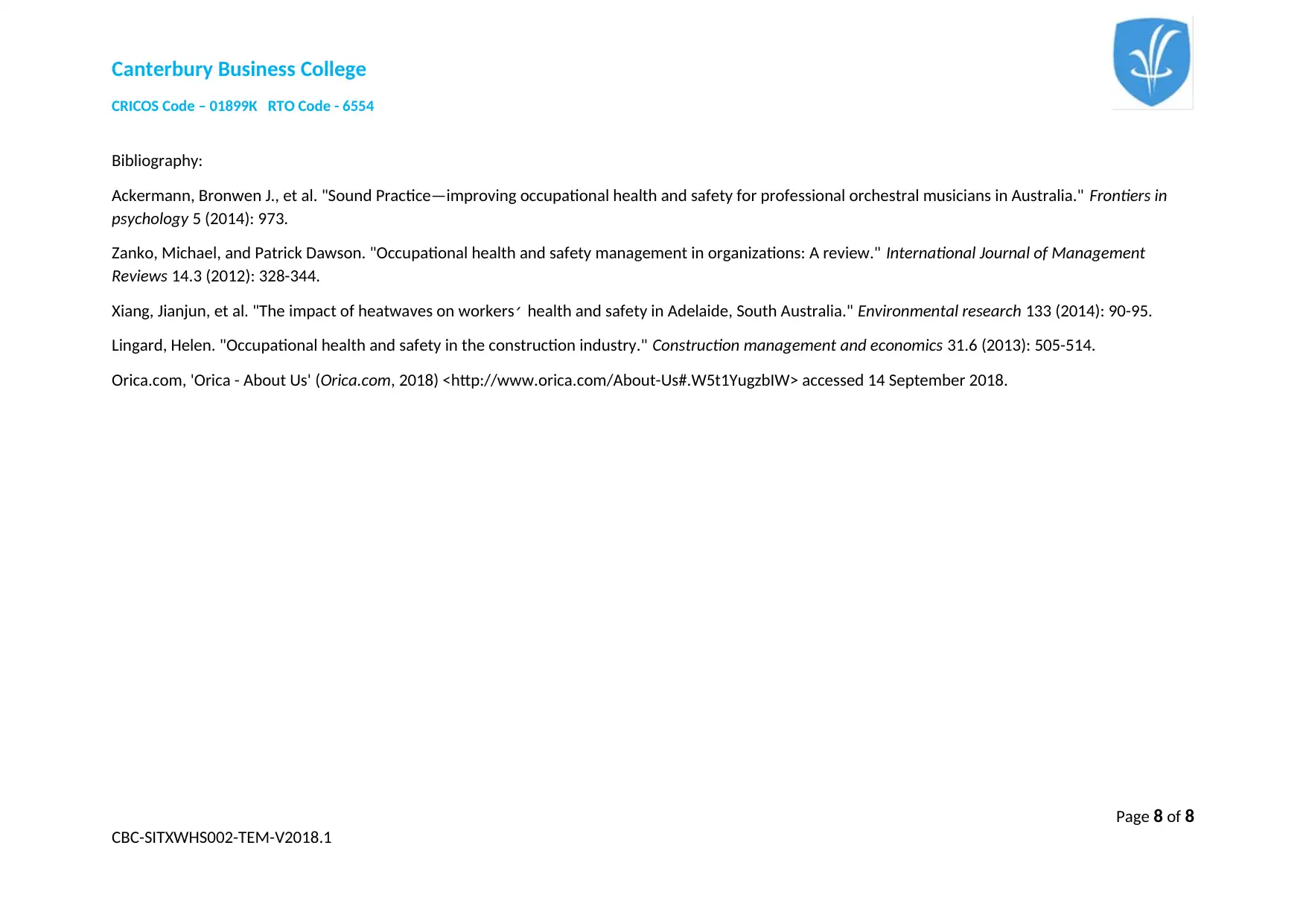
Canterbury Business College
CRICOS Code – 01899K RTO Code - 6554
Bibliography:
Ackermann, Bronwen J., et al. "Sound Practice—improving occupational health and safety for professional orchestral musicians in Australia." Frontiers in
psychology 5 (2014): 973.
Zanko, Michael, and Patrick Dawson. "Occupational health and safety management in organizations: A review." International Journal of Management
Reviews 14.3 (2012): 328-344.
Xiang, Jianjun, et al. "The impact of heatwaves on workers׳ health and safety in Adelaide, South Australia." Environmental research 133 (2014): 90-95.
Lingard, Helen. "Occupational health and safety in the construction industry." Construction management and economics 31.6 (2013): 505-514.
Orica.com, 'Orica - About Us' (Orica.com, 2018) <http://www.orica.com/About-Us#.W5t1YugzbIW> accessed 14 September 2018.
Page 8 of 8
CBC-SITXWHS002-TEM-V2018.1
CRICOS Code – 01899K RTO Code - 6554
Bibliography:
Ackermann, Bronwen J., et al. "Sound Practice—improving occupational health and safety for professional orchestral musicians in Australia." Frontiers in
psychology 5 (2014): 973.
Zanko, Michael, and Patrick Dawson. "Occupational health and safety management in organizations: A review." International Journal of Management
Reviews 14.3 (2012): 328-344.
Xiang, Jianjun, et al. "The impact of heatwaves on workers׳ health and safety in Adelaide, South Australia." Environmental research 133 (2014): 90-95.
Lingard, Helen. "Occupational health and safety in the construction industry." Construction management and economics 31.6 (2013): 505-514.
Orica.com, 'Orica - About Us' (Orica.com, 2018) <http://www.orica.com/About-Us#.W5t1YugzbIW> accessed 14 September 2018.
Page 8 of 8
CBC-SITXWHS002-TEM-V2018.1
1 out of 8
Your All-in-One AI-Powered Toolkit for Academic Success.
+13062052269
info@desklib.com
Available 24*7 on WhatsApp / Email
![[object Object]](/_next/static/media/star-bottom.7253800d.svg)
Unlock your academic potential
Copyright © 2020–2025 A2Z Services. All Rights Reserved. Developed and managed by ZUCOL.